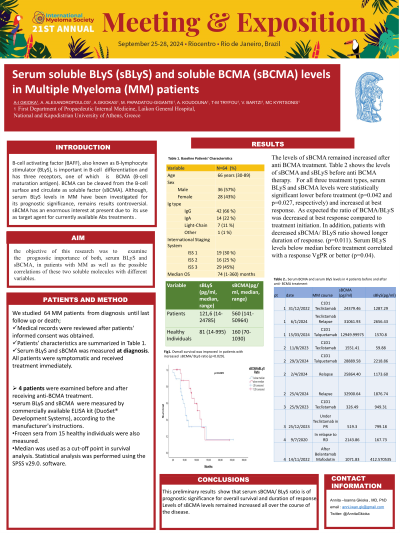MRD and Biomarkers
Serum BLYS and soluble (sBCMA) levels in Multiple Myeloma (MM) patients
P-168: Serum BLYS and soluble (sBCMA) levels in Multiple Myeloma (MM) patients
Thursday, September 26, 2024

- AG
Annita Ioanna Gkioka, MD, PhD
Haematology Resident
National and Kapodistrian University of Athens, Greece
Introduction:
B-cell activating factor (BAFF), also known as B-lymphocyte stimulator (BLyS), is important in B-cell differentiation and has three receptors, one of which is BCMA (B-cell maturation antigen). BCMA can be cleaved from the B-cell and circulate as its soluble factor (sBCMA). Although, serum BLyS levels have been investigated for their predictive importance, its prognostic significance remains controversial. sBCMA has an enormous interest at present due to the drugs that work against it. Thus, the objective of this research was to examine the prognostic importance of both, serum BLyS and sBCMA, in patients with MM as well as the possible correlations of these two soluble molecules with different therapies.
Methods: 64 MM patients from diagnosis until last follow up or death; Medical records were reviewed after patients' informed consent was obtained. Median age of patients was 66 years (57% men, 43% women). Ig type was IgG in 66%, IgA in 22%, light chain in 11% and IgD or biclonal in 1%. Thirty percent of patients were ISS 1, 25% ISS 2 and 45% ISS 3. Serum BLyS and sBCMA was measured at diagnosis. All patients were symptomatic and received treatment immediately. Furthermore, a subset of patients who received (Proteasome Inhibitor, N = 19, Immunomodulatory Drugs, N=16 and Daratumumab, N=22) were evaluated for serum BLyS and sBCMA before therapy. In addition, 4 patients were examined before receiving anti-BCMA treatment. serum BLyS and sBCMA were measured by commercially available ELISA kit (DuoSet® Development Systems), according to the manufacturer's instructions. Frozen sera from 15 healthy individuals were also measured. Median was used as a cut-off point in survival analysis. Statistical analysis was performed using the SPSS v29.0. software.
Results: Median serum BLyS levels at diagnosis were 121,6 pg/ml (range,14-24785) in patients and 81 pg/ml (range, 14-995) in HI and sBCMA levels were 560 pg/ml (range, 141-50964 ) in patients and 160 pg/ml (range, 70-1030) in HI. Overall survival was improved in patients with increased sBCMA/BLyS ratio (p=0.029). The levels of sBCMA were preserved increased all over the course of the disease. For all three treatment types, serum BLyS and sBCMA levels were statistically significant lower before treatment (p=0.042 and p=0.027, respectively) and increased at best response. As expected the ratio of BCMA/Blys was decreased at best response compared to treatment initiation. In addition, patients with decreased sBCMA/BLyS ratio showed longer duration of response. (p=0.011). Serum BLyS levels below median before treatment correlated with a response VgPR or better (p=0.04).
Conclusions: This preliminary results show that serum sBCMA/BLyS ratio is of prognostic significance for overall survival and duration of response. Levels of sBCMA levels remained increased all over the course of the disease. Indeed, we can not say if the levels were increased or decreased, since BCMA is cleaved from the cell surface.
B-cell activating factor (BAFF), also known as B-lymphocyte stimulator (BLyS), is important in B-cell differentiation and has three receptors, one of which is BCMA (B-cell maturation antigen). BCMA can be cleaved from the B-cell and circulate as its soluble factor (sBCMA). Although, serum BLyS levels have been investigated for their predictive importance, its prognostic significance remains controversial. sBCMA has an enormous interest at present due to the drugs that work against it. Thus, the objective of this research was to examine the prognostic importance of both, serum BLyS and sBCMA, in patients with MM as well as the possible correlations of these two soluble molecules with different therapies.
Methods: 64 MM patients from diagnosis until last follow up or death; Medical records were reviewed after patients' informed consent was obtained. Median age of patients was 66 years (57% men, 43% women). Ig type was IgG in 66%, IgA in 22%, light chain in 11% and IgD or biclonal in 1%. Thirty percent of patients were ISS 1, 25% ISS 2 and 45% ISS 3. Serum BLyS and sBCMA was measured at diagnosis. All patients were symptomatic and received treatment immediately. Furthermore, a subset of patients who received (Proteasome Inhibitor, N = 19, Immunomodulatory Drugs, N=16 and Daratumumab, N=22) were evaluated for serum BLyS and sBCMA before therapy. In addition, 4 patients were examined before receiving anti-BCMA treatment. serum BLyS and sBCMA were measured by commercially available ELISA kit (DuoSet® Development Systems), according to the manufacturer's instructions. Frozen sera from 15 healthy individuals were also measured. Median was used as a cut-off point in survival analysis. Statistical analysis was performed using the SPSS v29.0. software.
Results: Median serum BLyS levels at diagnosis were 121,6 pg/ml (range,14-24785) in patients and 81 pg/ml (range, 14-995) in HI and sBCMA levels were 560 pg/ml (range, 141-50964 ) in patients and 160 pg/ml (range, 70-1030) in HI. Overall survival was improved in patients with increased sBCMA/BLyS ratio (p=0.029). The levels of sBCMA were preserved increased all over the course of the disease. For all three treatment types, serum BLyS and sBCMA levels were statistically significant lower before treatment (p=0.042 and p=0.027, respectively) and increased at best response. As expected the ratio of BCMA/Blys was decreased at best response compared to treatment initiation. In addition, patients with decreased sBCMA/BLyS ratio showed longer duration of response. (p=0.011). Serum BLyS levels below median before treatment correlated with a response VgPR or better (p=0.04).
Conclusions: This preliminary results show that serum sBCMA/BLyS ratio is of prognostic significance for overall survival and duration of response. Levels of sBCMA levels remained increased all over the course of the disease. Indeed, we can not say if the levels were increased or decreased, since BCMA is cleaved from the cell surface.